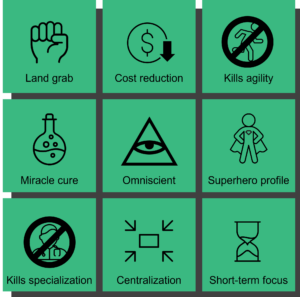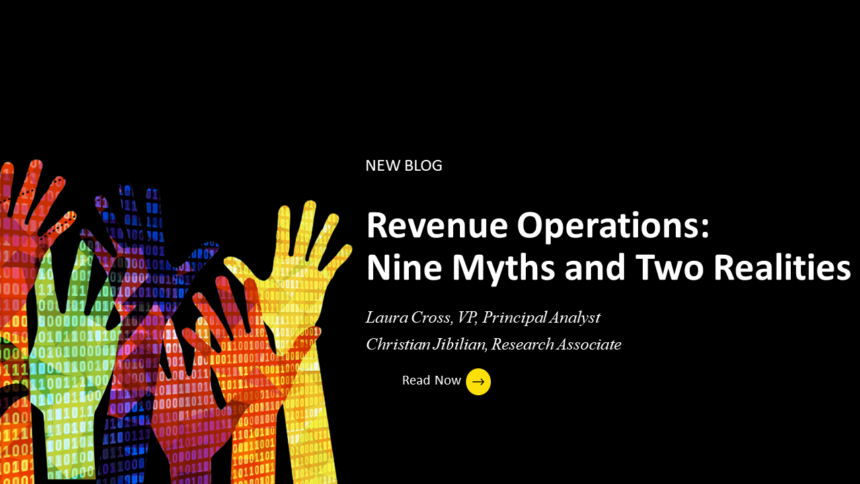When we talk to operations professionals and C-level leaders about their operational capabilities, we hear the following challenges:
- Our measurement is disjointed — no two teams are measuring in the same way.
- We lack alignment of strategy to execution based on business goals.
- We have a need for greater agility, more flexibility, and faster time to market.
- We’re still unable to leverage data in a meaningful way to align to customers’ needs.
- We have a ton of technical debt in the business.
- We’re using outdated processes that are not integrated across the business.
- We need to drive transformational change to better predict where revenue and growth are coming from and prioritize where to invest.
Revenue operations is getting so much attention recently as a way to overcome these challenges because B2B organizations tend to look to operations teams to harness and optimize resources. Forrester believes organizations would benefit from elevating and empowering operations teams, delivering a revenue operations capability now that integrates and unifies plans, processes, data, technology, and talent across the revenue ecosystem. Doing so not only drives a better customer experience but also brings an orderly approach to predicting and responding to today’s dynamic market environment. But revenue operations requires new capabilities, new roles, new processes, and a change-agent mindset from operations leaders — all of which can propagate concerns, threats, myths, and misconceptions about what revenue operations is and what it should be responsible for.
The top nine myths and misconceptions of revenue operations include:
- It’s a land grab.
- It’s a cost-reduction exercise.
- It kills agility.
- It’s a miracle cure.
- It’s omniscient.
- Leaders are superheroes.
- It kills specialization.
- It requires headcount centralization.
- It’s short-term-focused.

While each of these myths should be transparently addressed (and we do so in the report Dispelling Nine Myths And Misconceptions Of Revenue Operations, available to clients), we have to be careful that they don’t stop organizations from embracing and implementing a necessary revenue operations capability. Keep in mind that revenue operations should be seen as just that — a capability — well before any organizational structure or functional design commences.
Reality Number One: Revenue Operations Structures Are Tailored
Embedded in several of these myths is a fear that operational headcount centralization tips the power of control across the revenue ecosystem. But a direct reporting structure of all operational personnel is not the only option and may not even be your best option! Successful revenue operation organizational structures span everything from a completely decentralized model to a structurally unified centralized operations structure.
The ideal for many organizations may be a hybrid approach through a CoE (center of excellence) for select responsibilities such as data, analytics, and technology, for example. In this structure, operations functions — marketing operations, sales operations, and customer success operations — all work with the shared CoE for their respective data/technology requirements.
Regardless of the organizational structure, the goal of revenue operations is to reap the benefits of alignment and integration across the revenue ecosystem to maximize customer value and accelerate growth. Combining all ops functions into one without creating new capabilities, responsibilities, processes, or a change-agent mindset loses the big picture.
Reality Number Two: Revenue Operations Is A Strategic Partnership
Revenue operations (coordinating efforts among sales, marketing, and customer operations) forms a strategic partnership that best supports the C-suite. Operations teams enable growth and exceptional customer experiences by optimizing resources. To deliver on this vision, marketing operations, sales operations, and customer operations need to break down silos and integrate their actions. This partnership across operations personnel allows unified insights to be fed to executives at a critical time during strategic planning, aligns planning processes across the organization so that individual functions are working in a cohesive fashion, and project-manages the execution and adaptability of plans in an agile fashion when markets change. Through this unified revenue operations capability, the C-suite, especially the CEO and finance executive, empower the organization to maximize its commercial potential and optimize resources, reducing duplication, overlap, and rework.
How Forrester Can Help
The journey to a revenue operations strategy built around customer value and unification must start from a realistic place. We assist organizations in designing a best-practice revenue operations capability across marketing, sales, partner ecosystem, and customer success responsibilities. We help define each specialized team’s contribution to the business, develop more advanced capabilities for greater business impact, and distinguish the roles from each functional operations team.
Forrester Decisions for Revenue Operations will guide you to build a customer-obsessed operations strategy across the entire revenue ecosystem — dispelling all the myths and misconceptions and balancing the realities. By focusing your internal operations on delivering better customer experiences, your customers will grow. And when your customers maximize value, your organization will reach its full commercial potential.
Forrester clients can follow me for updates, and Forrester Decisions seatholders can request a guidance session with me or my colleagues to go deeper into our revenue operations research. You can also view our recent on-demand webinars on Nine Myths And Misconceptions Of Revenue Operations, The Future Of Revenue Operations, and Revenue Operations: Paving The Way To Brilliant Customer Experiences And Growth.








